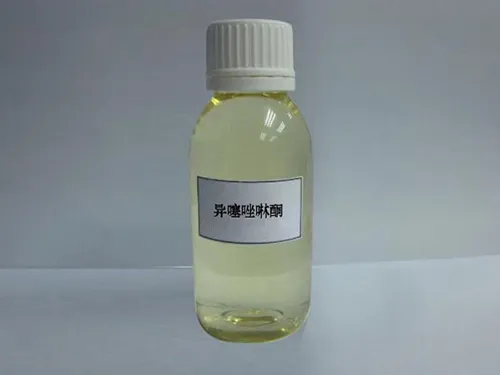Isothiazolinones: a versatile and versatile biocide with a wide range of applications
Isothiazolinones are an important class of heterocyclic organic compounds characterized by a sulfur-containing five membered ring. Due to their highly efficient biocidal activity, they are widely used in various industrial and consumer product fields. This article will explore the chemical structure, mechanism of action, application areas, as well as related environmental and safety issues of Isothiazolinones, with the aim of comprehensively understanding this widely used multifunctional biocide.

From a chemical structure perspective, the core structure of Isotriazolinones is a sulfur-containing Isotriazolinones ring
Different substituents attached to different positions of the ring can endow benzyl isothiazolinone with different physicochemical properties and biological activities. At present, common IT categories include methyl Isothiazolinones (MIT), chloromethyl Isothiazolinones (CMIT), benzo [b] Isothiazolinones (BIT), etc.
The mechanism of action of Isothiazolinones mainly lies in its inhibitory effect on microbial cells
Bit isothiazolinone binds to proteins in microbial cells, disrupting the integrity of the cell membrane, interfering with cell respiration and energy metabolism, ultimately leading to cell death. More specifically, IT can undergo irreversible reactions with key enzymes in microorganisms, inhibiting enzyme activity and thus preventing microbial growth and reproduction. This broad-spectrum bactericidal effect enables it to effectively inhibit the growth of bacteria, fungi, and algae.
It is precisely because of its efficient bactericidal performance that Isothiazolinones are widely used in many fields
In the industrial field, they are used as disinfectants and preservatives in cooling water systems, paper industry, leather industry and other fields, effectively preventing equipment corrosion and product deterioration caused by microbial growth. In the field of consumer goods, chloro isothiazolinone is often added to detergents, paints, coatings, adhesives, cosmetics, and other products to extend their shelf life and prevent microbial contamination. However, the use of IT in products such as cosmetics that come into direct contact with human skin has also raised concerns about their safety.
Isothiazolinones play an important role in protecting industrial and consumer products, but their potential environmental and safety issues are also receiving increasing attention
On the one hand, long-term use of chlorine methyl isothiazolinone may lead to microbial resistance and reduce its bactericidal effect. On the other hand, Isothiazolinones may be irritating and allergenic to certain populations, leading to adverse reactions such as skin allergies and contact dermatitis. In addition, the discharge of chloro methyl isothiazolinone may also have adverse effects on aquatic ecosystems, disrupting ecological balance.
Appropriate safety measures must be taken and the assessment of its environmental and health impacts must be strengthened when using Isothiazolinones
On the one hand, the potential risks to human health and the environment can be reduced by limiting the concentration and range of Isothiazolinones. On the other hand, we can actively develop safer and more environmentally friendly alternatives, such as bio based fungicides and physical sterilization technologies, to reduce our reliance on traditional chemical fungicides.
In summary, Isothiazolinones compounds play an important role as a widely used biocide in both industrial and consumer sectors. However, in the process of use, we must fully recognize its potential environmental and safety issues, and take effective measures to control and manage it. Future research directions should focus on developing safer and more environmentally friendly alternatives, achieving sustainable microbial control strategies to protect human health and the ecological environment.
Isothiazolinones FAQs
What are the main components of Isotriazolinones fungicide?
Common active ingredients include:
CMIT (5-Chloro-2-Methyl-4-isothiazolin-3-one): Rapid sterilization, but poor stability;
MIT (2-methyl-4-isothiazolin-3-one): Long acting antibacterial, often compounded with CMIT;
BIT (1,2-benzisothiazolin-3-one): High temperature resistant, suitable for high pH systems.
What is the main mechanism of action of Isothiazolinones?
To achieve sterilization/inhibition by disrupting the cell membrane and enzyme system of microorganisms:
Binding to cell membrane proteins leads to leakage of contents;
Inhibit respiratory function and energy metabolism (such as tricarboxylic acid cycle);
It is effective against bacteria, fungi, and algae, especially against sulfate reducing bacteria (SRB).
In which industrial fields is Isothiazolinone suitable?
Widely used in water treatment systems that require control of microbial growth:
Circulating cooling water (to suppress biofouling and corrosion);
Paper industry (pulp anti-corrosion);
Paint/lotion (anti-corrosion in tank);
Personal care products (shampoo, wet wipes for preservation, but with strict concentration control).
What is the safe concentration for the use of Isothiazolinones?
Industrial water treatment: usually 0.5-50 mg/L (adjusted according to microbial load);
Daily chemical products: MIT/CMIT total concentration ≤ 15 ppm (EU Regulation EC No. 1223/2009);
Caution: High concentrations may cause skin allergies, and protective equipment should be worn during operation.
What are the limitations or risks when using Isothiazolinones?
Key attention should be paid to:
Environmental toxicity: Harmful to aquatic organisms, requiring degradation treatment before discharge;
PH sensitivity: CMIT is prone to decomposition at pH>9.5, while BIT is more alkali resistant;
Compatibility: Avoid mixing with reducing agents (such as sulfite) or strong oxidizing agents (such as hydrogen peroxide);
Regulatory restrictions: Some countries prohibit CMIT/MIT (such as Japan's restriction on its use in coatings).
-
Water Treatment with Flocculant Water TreatmentاخبارJun.12,2025
-
Polymaleic AnhydrideاخبارJun.12,2025
-
Polyaspartic AcidاخبارJun.12,2025
-
Enhance Industrial Processes with IsothiazolinonesاخبارJun.12,2025
-
Enhance Industrial Processes with PBTCA SolutionsاخبارJun.12,2025
-
Dodecyldimethylbenzylammonium Chloride SolutionsاخبارJun.12,2025





